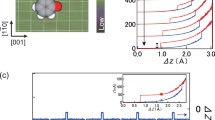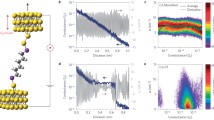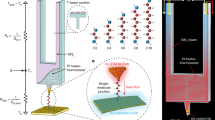Abstract
There is much discussion of molecules as components for future electronic devices. However, the contacts, the local environment and the temperature can all affect their electrical properties. This sensitivity, particularly at the single-molecule level, may limit the use of molecules as active electrical components, and therefore it is important to design and evaluate molecular junctions with a robust and stable electrical response over a wide range of junction configurations and temperatures. Here we report an approach to monitor the electrical properties of single-molecule junctions, which involves precise control of the contact spacing and tilt angle of the molecule. Comparison with ab initio transport calculations shows that the tilt-angle dependence of the electrical conductance is a sensitive spectroscopic probe, providing information about the position of the Fermi energy. It is also shown that the electrical properties of flexible molecules are dependent on temperature, whereas those of molecules designed for their rigidity are not.






Similar content being viewed by others
References
Cui, X. D. et al. Reproducible measurement of single-molecule conductivity. Science 294, 571–574 (2001).
Haiss, W. et al. Measurement of single molecule conductivity using the spontaneous formation of molecular wires. Phys. Chem. Chem. Phys. 6, 4330–4337 (2004).
Haiss, W. et al. Redox state dependence of single molecule conductivity. J. Am. Chem. Soc. 125, 15294–15295 (2003).
Xu, B. Q. & Tao, N. J. J. Measurement of single-molecule resistance by repeated formation of molecular junctions. Science 301, 1221–1223 (2003).
Weber, H. B. et al. Conductance properties of single-molecule junctions. Physica E 18, 231–232 (2003).
Reichert, J. et al. Driving current through single organic molecules. Phys. Rev. Lett. 88, 176804 (2002).
Metzger, R. M. et al. Unimolecular electrical rectification in hexadecylquinolinium tricyanoquinodimethanide. J. Am. Chem. Soc. 119, 10455–10466 (1997).
Feldheim, D. L. & Keating, C. D. Self-assembly of single electron transistors and related devices. Chem. Soc. Rev. 27, 1–12 (1998).
Klein, D. L., Roth, R., Lim, A. K. L., Alivisatos, A. P. & McEuen, P. L. A Single-electron transistor made from a cadmium selenide nanocrystal. Nature 389, 699–701 (1997).
Chen, J., Reed, M. A., Rawlett, A. M. & Tour, J. M. Large on-off ratios and negative differential resistance in a molecular electronic device. Science 286, 1550–1552 (1999).
Collier, C. P. et al. Electronically configurable molecular-based logic gates. Science 285, 391–394 (1999).
Andres, R. P. et al. “Coulomb” staircase at room temperature in a self-assembled molecular nanostructure. Science 272, 1323–1325 (1996).
Haiss, W. et al. Molecular wire formation from viologen assemblies. Langmuir 20, 7694–7702 (2004).
Haiss, W. et al. Thermal gating of the single molecule conductance of alkanedithiols. Faraday Discus. 131, 253–264 (2006).
Kornyshev, A. A. & Kuznetsov, A. M. Single molecule tunnelling conductance: the temperature and length dependences controlled by conformational fluctuations. Chem. Phys. 324, 276–279 (2006).
Kornilovitch, P. E. & Bratkovsky, A. M. Orientational dependence of current through molecular films. Phys. Rev. B 64, 195413 (2001).
Geng, W. T., Nara, J. & Ohno, T. Impacts of metal electrode and molecule orientation on the conductance of a single molecule. Appl. Phys. Lett. 85, 5992–5994 (2004).
Rocha, A. R. et al. Spin and molecular electronics in atomically-generated orbital landscapes. Phys. Rev. B 73, 085414 (2006).
Reily Rocha, A. et al. Towards molecular spintronics. Nature Mater. 4, 335–339 (2005).
Seminario, J. M., Zacarias, A. G. & Tour, J. M. Theoretical interpretation of conductivity measurements of a thiotolane sandwich. A molecular scale electronic controller. J. Am. Chem. Soc. 120, 3970–3974 (1998).
Haiss, W., Lackey, D., Sass, J. K. & Besocke, K. H. Atomic resolution scanning tunneling microscopy images of Au(111) surfaces in air and polar organic-solvents. J. Chem. Phys. 95, 2193–2196 (1991).
Acknowledgements
This work was supported by EPSRC (Mechanisms of Single Molecule Conductance) (Liverpool), Basic Technology (Controlled Electron Transport) (Durham and Lancaster) and a Lancaster–EPSRC Portfolio Partnership and MCRTN Fundamentals of Nanoelectronics.
Author information
Authors and Affiliations
Corresponding author
Ethics declarations
Competing interests
The authors declare no competing financial interests.
Supplementary information
Supplementary Information
Supplementary information, figures and movie legend (PDF 537 kb)
Supplementary movie
Supplementary movie 1 (WMV 1903 kb)
Rights and permissions
About this article
Cite this article
Haiss, W., Wang, C., Grace, I. et al. Precision control of single-molecule electrical junctions. Nature Mater 5, 995–1002 (2006). https://doi.org/10.1038/nmat1781
Received:
Accepted:
Published:
Issue Date:
DOI: https://doi.org/10.1038/nmat1781
- Springer Nature Limited
This article is cited by
-
Controlling piezoresistance in single molecules through the isomerisation of bullvalenes
Nature Communications (2023)
-
Mechanical single-molecule potentiometers with large switching factors from ortho-pentaphenylene foldamers
Nature Communications (2021)
-
Tuning surface d bands with bimetallic electrodes to facilitate electron transport across molecular junctions
Nature Materials (2021)
-
A Mechanical Single-molecule Potentiometer Based on Foldamer
Chemical Research in Chinese Universities (2021)
-
Tuning electrical conductance of molecular junctions via multipath Ru-based metal complex wire
Indian Journal of Physics (2020)





